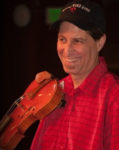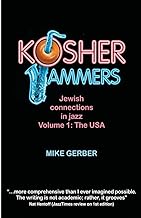By Yale Strom

 SAN DIEGO — Kosher Jammers: Jewish Connections in Jazz Volume 1: The USA by Mike Gerber is an encyclopedic catalogue every African-American and Jewish musician who bridged Jazz and Jewish music. Gerber’s extensive research is primarily based upon his personal interviews with the musicians, as well as interviews with jazz scholars such as Dan Morgenstern and Loren Schoenberg.
SAN DIEGO — Kosher Jammers: Jewish Connections in Jazz Volume 1: The USA by Mike Gerber is an encyclopedic catalogue every African-American and Jewish musician who bridged Jazz and Jewish music. Gerber’s extensive research is primarily based upon his personal interviews with the musicians, as well as interviews with jazz scholars such as Dan Morgenstern and Loren Schoenberg.
Readers who are not musicians will be immersed in how Jews were among the most prolific composers of the biggest hits that make up what we call today the “American Songbook.” From the 1920’s through the early 1950’s, luminaries like Harold Arlen (Hyman Arluck) Yip Harburg (Isidore Hochberg) and countless others wrote tunes that became the jazz standards that helped make Louis Armstrong, Ella Fitzgerald, Billie Holiday, Coleman Hawkins, Charlie Parker, Teddy Wilson, et al, world famous.
As Gerber writes: “Whether the greatest jazz standards songs were composed by Jews or not, they are part of the DNA of jazz. Whether or not you agree they had a pivotal role in jazz evolution, jazz would be poorer, and definitely less popular, without this treasury of material to draw upon.”
We learn that discrimination against both groups (Jews and African Americans) by the majority WASP Americans from the late 19th century through the 1950s closed many doors to any hope of economic success. White Christian America resented the influx of East European Jewish immigrants, a hatred ingrained in the antisemitic trope blaming them for the death of Jesus. Jews who assimilated, even converted, were tolerated a bit more, but African-Americans were not accepted at all because of their skin color. And assimilation was impossible before the Civil Rights Era.
Gerber details how the doors of entertainment were always open to anyone who was stupid enough to think they could make a living from it. Consequently, many Jews and African-Americans found themselves rubbing shoulders in the music business.
Packed with facts and trivia, this book will be full of surprises for the reader. The writing can be a bit dense at times where some things could be said much more succinctly. Some judicious editing was needed and the layout of the book is a bit messy. For example, the large type footnotes at the end of a sentence in the middle of a paragraph can be confusing and distracting.
One correction I have to make is for footnote No. 8 in Chapter 11. Gerber writes about the cellist Fred Katz who played jazz (Chico Hamilton), classical, folk and Chasidic music and played in the San Diego Jewish Festival’s Klezmer Summit concert “Jews and Jazz” just before he passed away in September 2013. I visited Fred (and jammed with him as well) in February 2013, but he never made it to the June concert, as he was too sick to travel.
Whether it is the klezmer crying on the violin or the jazz cat moaning on the tenor sax, it is more than just notes and scales that connect these two peoples and their cultures.
*
Thanks for the well written and informative review. Gotta get my hands on the book!